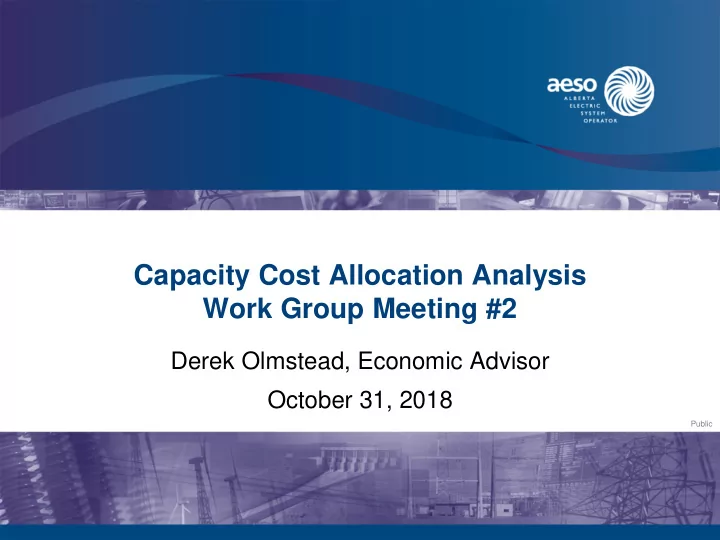

Capacity Cost Allocation Analysis Work Group Meeting #2 Derek Olmstead, Economic Advisor October 31, 2018 Public
Agenda • Review and discussion of analysis circulated by the AESO – Capacity Cost Rate Estimator Tool – Day-HE-Month Distribution of Expected Unserved Energy in the 2022-23 Capacity Obligation Year – Note: All analysis is in draft form; no decisions have been made or have been endorsed by the AESO • Recommendations for the Tariff Design Advisory Group (TDAG) meeting on November 8 • Next steps Public 1
Capacity Cost Rate Estimator Tool Public
Capacity cost rate estimator: Preliminary version • The spreadsheet tool estimates the capacity cost rates that would apply to energy consumption based on: – A variety of user-provided assumptions – Embedded assumptions about cost allocation process • Important disclaimers about the tool: – The tool is in a preliminary form and the AESO cautions against drawing conclusions based on its results. – The tool has not been audited for correctness. – The AESO does not: • Endorse any of the assumptions upon which the tool operates • Certify that these assumptions are consistent with policy decisions • Endorse the preliminary results that may be derived from the tool Public 3
Assumptions built into the tool (not exhaustive) • All weekdays that are not holidays in a calendar month are treated the same; all weekends and holidays in a calendar month are treated the same – i.e., all weekday, non-holiday HE 15 in July are assigned to the same time period (bin) and have the same weight • Consumption data are 2016 hourly DTS quantity (8784 hours) • No feedback of capacity costs on the level of hourly consumption Public 4
User inputs: Specification of the time periods • The user must allocate the weekday/weekend-HE-month to a time period (bin) – Tool allows for up to 8 time periods to be specified – Insert numbers 1 through 8 into the yellow matrices (next slide) – Time period numbers themselves are arbitrary • Based on these inputs the tool will: – Add up the number of hours of the obligation year that fall into each time period (8784 hours in total since the underlying data are from 2016) – Calculate the average demand in each time period • To be clear, the tool does not determine how the time periods are to be specified Public 5
Allocation of day-HE-month periods to (capacity) time periods Public 6
User inputs: Time period (bin) weights and the capacity revenue requirement • For each time period (bin) to which a positive number of hours are allocated, the user must specify the time period (bin) weight – The restrictions set out in policy are not hard-coded as constraints in the tool – The user must check whether the relevant constraints are satisfied – Insert into the yellow column (next slide) • The user must specify the capacity revenue requirement in dollars, i.e., the amount of money that must be raised by the WEM to fund capacity payments in the obligation period Public 7
Assumptions and estimated rates Public 8
Feedback • WG discussion and feedback • Usefulness and enhancements? – Source of user-provided inputs • Time periods • Time period weights • Capacity revenue requirement – Limitations of 2016 DTS data • Based on incentives and effects that were relevant in 2016 – Feedback effect of capacity costs on consumption requires additional analysis Public 9
Day-HE-Month Distribution of Expected Unserved Energy in the 2022-23 Capacity Obligation Year Public
Description of data and analysis • The table on the next slide show that fraction of Expected Unserved Energy (EUE) for the capacity obligation year 2022-23 broken down by: – Weekday / weekend – Hour-ending (HE) – Month • Underlying capacity is minimum procurement volume necessary to satisfy the resource adequacy requirement • Important caveat: – The minimum procurement volume and the methodology and assumptions underpinning it have not been approved by the Alberta Utilities Commission – Therefore, the results in the spreadsheets are subject to change Public 11
Visualization of Day-HE-Month distribution of EUE Public 12
Feedback • WG discussion and feedback • Use of data to specify WEM parameters: – Time periods – Time period weights • Recommended extensions and additional analysis – Level of capacity? • Consistency of input and potential integration with the Capacity Cost Rate Estimator Tool Public 13
Thank you Public
Recommend
More recommend